“The Triumph of Death” by Pieter Bruegel the Elder – An Analysis
The Triumph of Death painting was produced by the Northern Renaissance artist Pieter Bruegel the Elder. The Triumph of Death by Pieter Bruegel the Elder portrays a landscape in which hordes of skeletons wreak deadly havoc in a grim landscape. This artwork was a portrayal of the ever-present fear of death that accompanied life in Europe at the time. Below, we will explore this famous work’s composition and meaning.
Understanding The Triumph of Death by Pieter Bruegel the Elder
| Artist | Pieter Bruegel the Elder (1525 – 1569) |
| Date Completed | 1562 |
| Medium | Oil on panel |
| Dimensions (cm) | 117 x 162 |
| Location | Museo Nacional del Prado, Madrid, Spain |
In the artist’s lifetime, there was the prospect of death around practically every corner. There were plagues to deal with, ongoing fights between Reformers and Catholics, as well as more religious wars involving Flanders and Spain. It was in this context that Bruegel the Elder produced The Triumph of Death painting. The landscape is desolate and devoid of life of any kind. The scene is filled with fires and doom and a legion of skeletons can be seen destroying everything. Before we discuss The Triumph of Death painting in any more detail, let us introduce you to its artist, Pieter Bruegel the Elder.
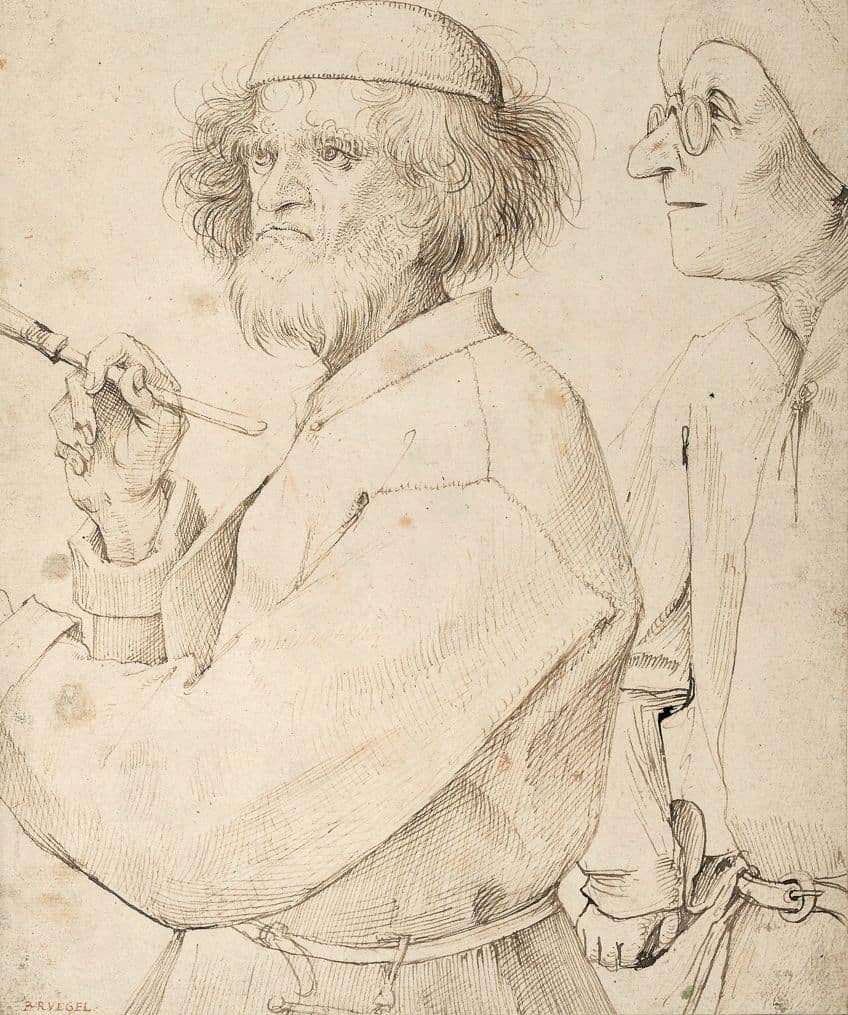
Introducing Pieter Bruegel the Elder
| Artist Name | Pieter Bruegel the Elder |
| Nationality | Dutch |
| Date of Birth | c. 1525 |
| Date of Death | 9 September 1569 |
| Place of Birth | Breda, the Netherlands |
Given his immense popularity today, it’s surprising how little art historians know about Pieter Bruegel the Elder. One would think that there would be an abundance of information regarding the artist, yet even the place and date of his birth are still open to debate. His signature at the Antwerp Artist’s Guild of St. Luke in 1551 is the first verifiable evidence of his existence. We also know that he died in Brussels in 1569, as verified by a church memorial made by his son.
As among the first generation of painters to grow up after subjects related to religion were no longer considered to be the predominant subject matter of art, Pieter Bruegel the Elder had a significant impact on Dutch Golden Age painting and art history in general.
Bruegel the Elder was the most famous member of a famous southern Dutch family of artists who produced art for four generations in the 16 and 17th centuries. Bruegel humanized traditional topics while also attempting to develop new ones. He was an astonishingly innovative artist and draftsman, and his influence was enormous and long-lasting due to his continuation of the family profession and the business that grew around the prints of his works. Unlike the other artists from the Netherlands, he did not paint any portraits. After he had trained in Italy, he returned to Antwerp in 1555 to work primarily as a prominent print designer for the most renowned publisher of his time.

It was only at the end of the 1550s that he converted to painting as his primary medium, and all of his renowned works date from the period preceding his early death, when he was presumably in his early 40s and at the peak of his career. Pieter Bruegel specialized in peasant genre paintings, generally featuring landscapes, although he also produced religious pieces. Bruegel’s use of landscape resists easy interpretation and represents possibly the artist’s most innovative work.
Working in the years following the Reformation, he was able to free his landscapes from established iconographic tradition, resulting in a contemporary depiction of the natural world.
Making the lives and practices of peasants the central focus of an artwork was unusual during the artist’s time, therefore he was seen as a pioneer of genre painting. His artistic progression can be followed all the way from his early landscapes, as he signed his works, making them easy to identify. We can see this progression from his early works, which are influenced by the Flemish landscape tradition of the 16th century, to his later works, which are Italianate. In addition to a huge number of engravings and drawings, 45 paintings have been authenticated as being the work of Bruegel, yet it is believed that this is just a small part of his overall output, much of which has been lost to time.
Analysis of The Triumph of Death by Pieter Bruegel the Elder
This is not your typically idyllic landscape scene. The trees are all bare and the shores are full of rotting fish. The ground is burnt and barren and filled with human corpses. Those poor souls who are still alive are either engaged in battle or running away from the horse of skeletons that descend upon them. Let’s take a closer look at The Triumph of Death painting below.
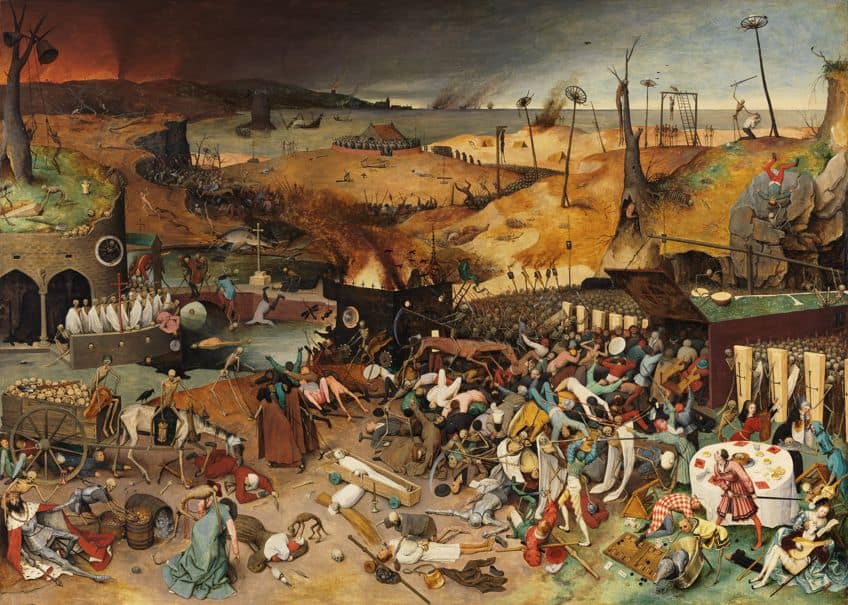
Description
Bruegel is able to depict an extensive view of death and destruction because of the elevated viewpoint he used in this painting. The artwork depicts aspects of mid-sixteenth-century life when the threat of plague was always present. Skeletons can be seen pulling a wagon loaded with the skulls of the dead in the painting’s foreground. Others can be seen striking the bell that represents the world’s death knell in the upper left corner of the artwork. A skeleton can be seen riding on horseback into the crowds of people, forcing them to all herd into a coffin-like box, swinging his scythe through the masses.
The skeletons do not seem to discriminate between who they take down, as people from all classes and backgrounds can be seen suffering in this painting, from nobility and kings to soldiers and peasants alike.
A skeleton mocks human pleasure by performing on a hurdy-gurdy while his cart’s wheels squash a man as though he is completely insignificant. A lady is also being run over by the art. She holds a thin thread that is about to be severed with scissors, which some say is Bruegel’s depiction of Atropos. Another woman in the route of the death wagon is holding a distaff and spindle. These are traditional symbols of human life’s fragility and are thought to represent Bruegel’s version of Lachesis and Clotho. A skeleton dressed in a red hat assists a cardinal towards the coffin-shaped box, while a second skeleton steals coins from a dying king. The dying thoughts of the ignorant king are still focused on his money, seemingly oblivious to his fate. In the middle, a skeleton can be seen cutting a pilgrim’s throat and taking his money bag, while above the murder, skeleton fishermen can be observed capturing people with a net.
It seems that some sort of banquet in the lower right-hand corner was disturbed mid-feast by the skeleton hordes, and the guests are ineffectively trying to fight back with their swords. The court jester can also be seen looking for a place to hide underneath the table. We can see two women positioned above this table. One of them tries to escape the embrace of one of the skeletons, said to represent the usually playful and amorous interaction between diners after a feast. The other woman seems horrified as a skeleton approaches her with a dinner plate full of bones.
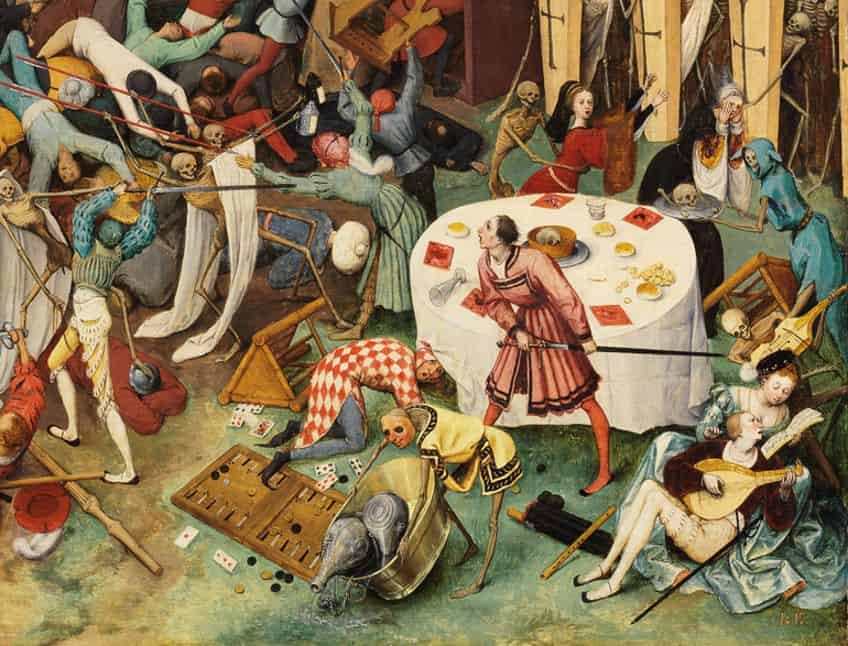
A couple of people can be seen playing music and singing in the lower right corner of the canvas, seemingly unaware of their impending doom as a skeleton standing behind them plays along to their music. The horizon is blurred with smoke from nearby villages that are on fire. A burial ceremony is also depicted, as are several means of execution, such as the gallows, the breaking wheel, being burnt at the stake, and the headsman poised to chop off the head of someone who has just received communion. One poor citizen is the target of a skeleton hunter and his hounds in one part of the painting and skeletons take captives down to be drowned in a pond in another. The skeletons have prevailed, and this is the new reality that the citizens now face instead of the world they were accustomed to.
Bruegel chose to cast the entire painting in a reddish-brown tone, lending the picture a hellish quality that is entirely suited for the subject being portrayed. Just by looking at it, it’s evident why Pieter Bruegel the Elder was regarded as Hieronymus Bosch’s artistic heir.
Themes
The most dominant theme in this artwork is about how death is inescapable to every person, no matter what their social rank in life. We can see kings, clergy, and peasants alike all being slaughtered by death in the form of skeletons on horseback. This serves as a stark reminder of our own mortality, which was a popular theme during the Renaissance period, known as a Memento Mori. Some aspects of the artwork, such as the dead monks and priests and the church spires, imply that death is merciless and doesn’t spare religious people or those in positions of authority within the faith. This could possibly be perceived as a critique of the clergy’s hypocrisy and corruption during Bruegel’s time. Several scenes in the artwork depict individuals attempting to run away from the approaching skeletons, but they are eventually unsuccessful. This serves to illustrate the pointlessness of humans trying to escape their own deaths.
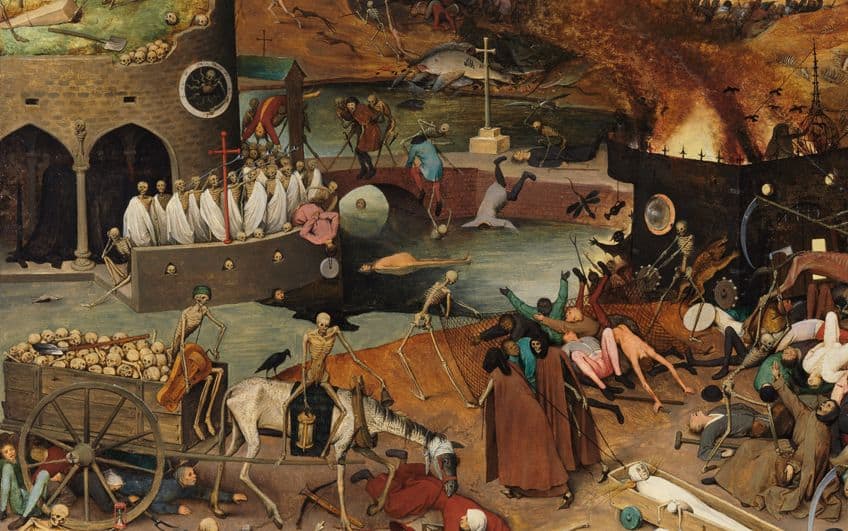
Social Commentary
Pieter Bruegel the Elder lived at a time characterized by intense political, social, and religious upheaval in 16th-century Europe. The Protestant Reformation arose in the 16th century, challenging the Catholic Church’s authority. Religious conflicts, often involving the persecution of religious minorities, also occurred throughout this time period. Bruegel portrays people from all walks of life and religious backgrounds surrendering to the power of death. This could represent that religious wars themselves were futile as they would lead all to their deaths, no matter their various beliefs.
During Bruegel’s time, Europe had been devastated by various conflicts, and this painting depicts scenes of combat, with troops on horseback and infantry creating havoc all around.
The imagery of war-torn landscapes and burning settlements might be interpreted as a statement on the horrific impact of war on human civilization. Periodic famines and plague outbreaks also occurred throughout the 16th century causing widespread misery and death. People experiencing starvation and disease are depicted in the artwork to illustrate the sad truth of these plagues and the feelings of powerlessness experienced by these people who have to face such tragic and often horrific events.
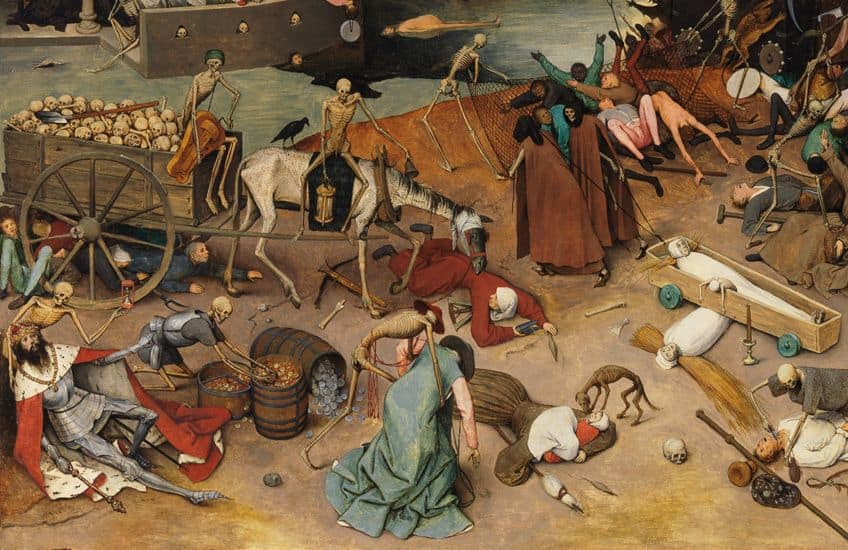
Restoration
Following a successful restoration process in 2018, the Museo Nacional del Prado once again exhibited the artwork. The restoration of this remarkable artwork by Mara Antonia López de Asiain and José de la Fuente, who restored both its original colors and structural stability. Unfortunately, the original artwork was hidden behind an incredible amount of repainting from previous restoration efforts, which were then covered by colored varnishes that ultimately provided it with a uniform impression. This is why the overall appearance has been changed into an almost monochromatic tone. Fortunately, infrared reflectography and a thorough investigation of the copies created by Bruegel’s sons have allowed for the precise reintegration of minor elements that were lost through inaccurate reconstructions of the image’s previous restorations.

Pieter Bruegel the Elder was mocked by Jacob Burckhardt, a 19th-century historian from Switzerland, who described him as a vulgar artist. Yet, the exact trait that Burkhardt derided, namely the willingness to incorporate seasonal atmosphere and realism into his moral stories, is exactly what makes Pieter Bruegel the Elder so appreciated today. In this artwork, however, the realities are grim and the season is one of death. In The Triumph of Death painting, the Northern Renaissance artist shows us all the horrid yet creative ways there are for one to die in the 16th century in one grim landscape. It ultimately expresses that there is no one that can escape their fate, no matter their position in life – death comes for kings and peasants with the same scythe and no one ever escapes.
Frequently Asked Questions
Who Is Pieter Bruegel the Elder?
Pieter Bruegel the Elder was a 16th-century Dutch artist who came from a family of famous artists. He was a Northern Renaissance artist, yet unlike the other artists from the area, he did not focus on producing portraits. He was known for his landscape paintings, one of which is the famous The Triumph of Death painting. Bruegel is regarded as a pioneer of genre painting, depicting scenes of working life with empathy, honesty, and occasionally humor. He was viewed as breaking away from the mainstream Italian Renaissance style, making works that concentrated on landscape and contemporary life rather than the big myths favored by the painters of the previous century.
What Is The Triumph of Death by Pieter Bruegel the Elder About?
This landscape is a depiction of death ravaging a town. People of all classes of life can be seen being attacked by hordes of skeletons who round up the humans and march them to their inevitable fates. Death commands his forces from his steed in the painting’s foreground, swiftly devastating the realm of the living. The background, a bleak landscape with scenes of destruction and slaughter, is as terrifying as the rest of the piece. It represents the many ways in which one could die in the 16th century and is a message about how no person will manage to escape death, no matter who they are and what they do in life.
Jordan Anthony is a Cape Town-based film photographer, curator, and arts writer. She holds a Bachelor of Art in Fine Arts from the University of the Witwatersrand, Johannesburg, where she explored themes like healing, identity, dreams, and intuitive creation in her Contemporary art practice. Jordan has collaborated with various local art institutions, including the KZNSA Gallery in Durban, the Turbine Art Fair, and the Wits Art Museum. Her photography focuses on abstract color manipulations, portraiture, candid shots, and urban landscapes. She’s intrigued by philosophy, memory, and esotericism, drawing inspiration from Surrealism, Fluxus, and ancient civilizations, as well as childhood influences and found objects. Jordan is working for artfilemagazine since 2022 and writes blog posts about art history and photography.
Learn more about Jordan Anthony and about us.
Cite this Article
Jordan, Anthony, ““The Triumph of Death” by Pieter Bruegel the Elder – An Analysis.” artfilemagazine – Your Online Art Source. October 6, 2023. URL: https://artfilemagazine.com/the-triumph-of-death-by-pieter-bruegel-the-elder/
Anthony, J. (2023, 6 October). “The Triumph of Death” by Pieter Bruegel the Elder – An Analysis. artfilemagazine – Your Online Art Source. https://artfilemagazine.com/the-triumph-of-death-by-pieter-bruegel-the-elder/
Anthony, Jordan. ““The Triumph of Death” by Pieter Bruegel the Elder – An Analysis.” artfilemagazine – Your Online Art Source, October 6, 2023. https://artfilemagazine.com/the-triumph-of-death-by-pieter-bruegel-the-elder/.



